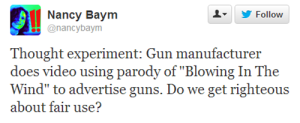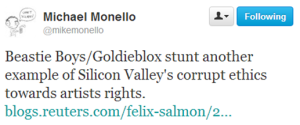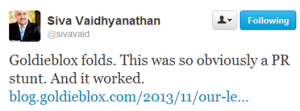(RIP MCA)
Toy company Goldieblox recently released a video of girl children rejecting the narrow toy options available to them and instead engineering a Rube Goldberg machine out of typically feminine toys to the soundtrack of the Beastie Boys’ classic 1986 song “Girls,” rewritten to have pro-Girls-in-STEM lyrics.
Controversy ensued. It was seemingly contained to the feminist internet or the technology/copyright internet, and happening in parallel in them with little cross-pollination except for feminist copyright scholars, so those not hooked into those circuits of knowledge circulation may have missed it. (I’d embed or link to the video but it no longer exists in that form.)
I’ll admit that my first thought when I saw the video was “That’s so cool of the Beastie Boys to authorize this!”
I then immediately had to revoke my own scholar card, because the whole point of fair use is that copyright holders don’t have to authorize it.
But after I copied out Section 107 of the copyright code 50 times in penance, I kept reading the various takes on it that went across my Twitter feed. And this tweet
 from @nancybaym (retweeted to me by @mikemonello) was when I knew I had to write about it:
from @nancybaym (retweeted to me by @mikemonello) was when I knew I had to write about it:
This is an incredibly powerful example, and Baym is entirely right that such a parody would provoke horror in a lot of people (me included). And while in one sense it is a valid parallel, because it would involve a re-user producing a song dramatically opposite to the message of the original for the purposes of advertising, in another sense the two aren’t comparable at all.
A more powerful social position (pro-gun) co-opting a less powerful social position (pro-peace) just isn’t the same as a less powerful social position (pro-girl) co-opting a more powerful social position (wildly sexist). The Goldieblox controversy, that is, is a textbook example of the argument I’m starting to formulate: The meaning of an act of reuse depends on who’s doing it. (Not legally, of course, but culturally and maybe even morally.)
To know what to make of the Goldieblox “Girls” parody, then, “Who’s doing it?” is the key question.
Are they pro-girl transformative creators who only preemptively sued out of a need to protect themselves from beastly Beasties and their lawyers? (Also, is pre-emptive suing to have works declared non-infringing becoming more common [cf. Robin Thicke/Marvin Gaye], or am I just paying more attention now?) This is how their defenders and those focusing on the message of the video have portrayed it.
Or are the Goldieblox folks cynical opportunists who wanted to trade on the familiarity of “Girls” or the cognitive dissonance of the new lyrics against the misogynist original or who hoped there’d be attention-generating controversy?
My contention is that we get such wildly divergent responses to the piece because it’s not clear who’s doing it. Likely we’ll never be able to definitively answer that question, and in some sense they’re both of those things. Perhaps there’s an aspect of Rorschach testing here: What you see in this case indexes how you see the world generally.
However, Felix Salmon notes in the article linked by @mikemonello above, “Given the speed with which the GoldieBlox complaint appeared, indeed, it’s reasonable to assume that they had it in their back pocket all along, ready to whip out the minute anybody from the Beastie Boys, or their record label, so much as inquired about what was going on.”
This tips it much farther to the opportunist side—knowing about these legal machinations makes the “just pro-girl” reading much harder to sustain. But the feminist interpretation is still there, and it inclined a lot of people to support the video, even with the copyright infringement angle. Indeed, if Goldieblox had been less antagonistic there’s every chance the balance of support would have been in their favor.
But, as Salmon points out, “GoldieBlox neither sought nor received permission to create these videos: it never licensed the music it used from the artists who wrote it. That wouldn’t be the Silicon Valley way. First you make your own rules — and then, if anybody tries to slap you down, you don’t apologize, you fight.”
With further analysis, then, Goldieblox looks increasingly unlike an underdog.
In a Gigaom piece, (via @sivavaid), Jeff John Roberts says, “A quick visit to GoldieBlox’s website reveals terms of service that are about as reasonable as the Spanish Inquisition; the terms includes gems like this one: ‘We grant you a limited, non-exclusive, revocable, non-assignable, personal, and non-transferable license to create hyperlinks to the Website.’”
The idea that a hyperlink needs a license shows them to be a) unfamiliar with how the internet works, b) unfamiliar with standard conventions of writing offline or on, and c) copyright maximalists when it’s their stuff, i.e. hypocritical.
Roberts adds, “At the same time, the Beastie Boys themselves long-ago eschewed the sort of beer-swilling sexism of their debut album, and became advocates for women amidst a general hip-hop climate of misogyny.” So even as Goldieblox looks less good when you look more closely, the Beasties are less bad.
And this sort of nuance is exactly why I contend that we have to tease this stuff out, to parse as precisely as possible who’s doing what to who and how.
Corynne McSherry demonstrates in her analysis for the Electronic Frontier Foundation that the Goldieblox video is probably fair use by the four-factor test. However, if this cultural moment shows anything it’s that it’s the cultural lives of intellectual property (to use Rosemary Coombe’s title) that are far more interesting.


